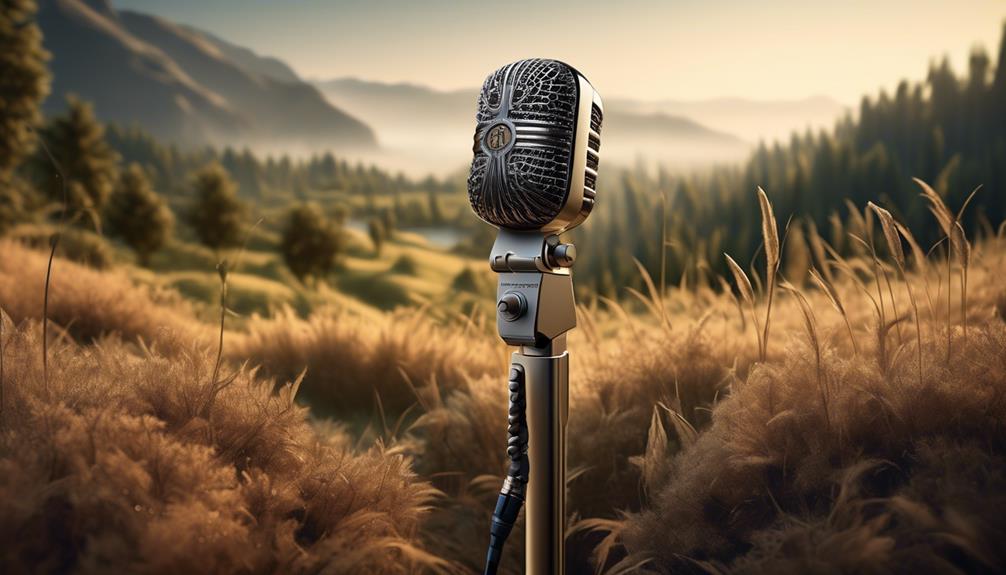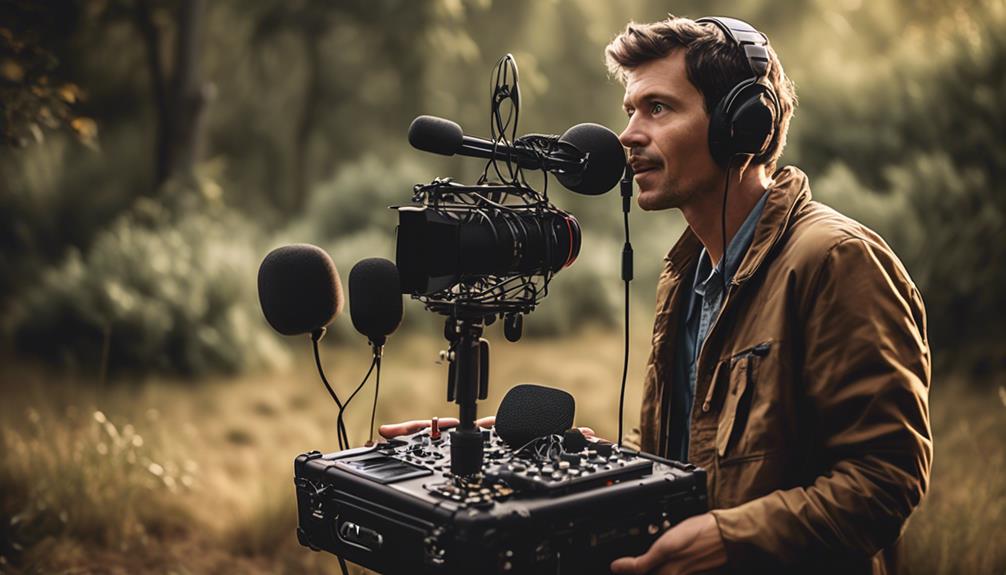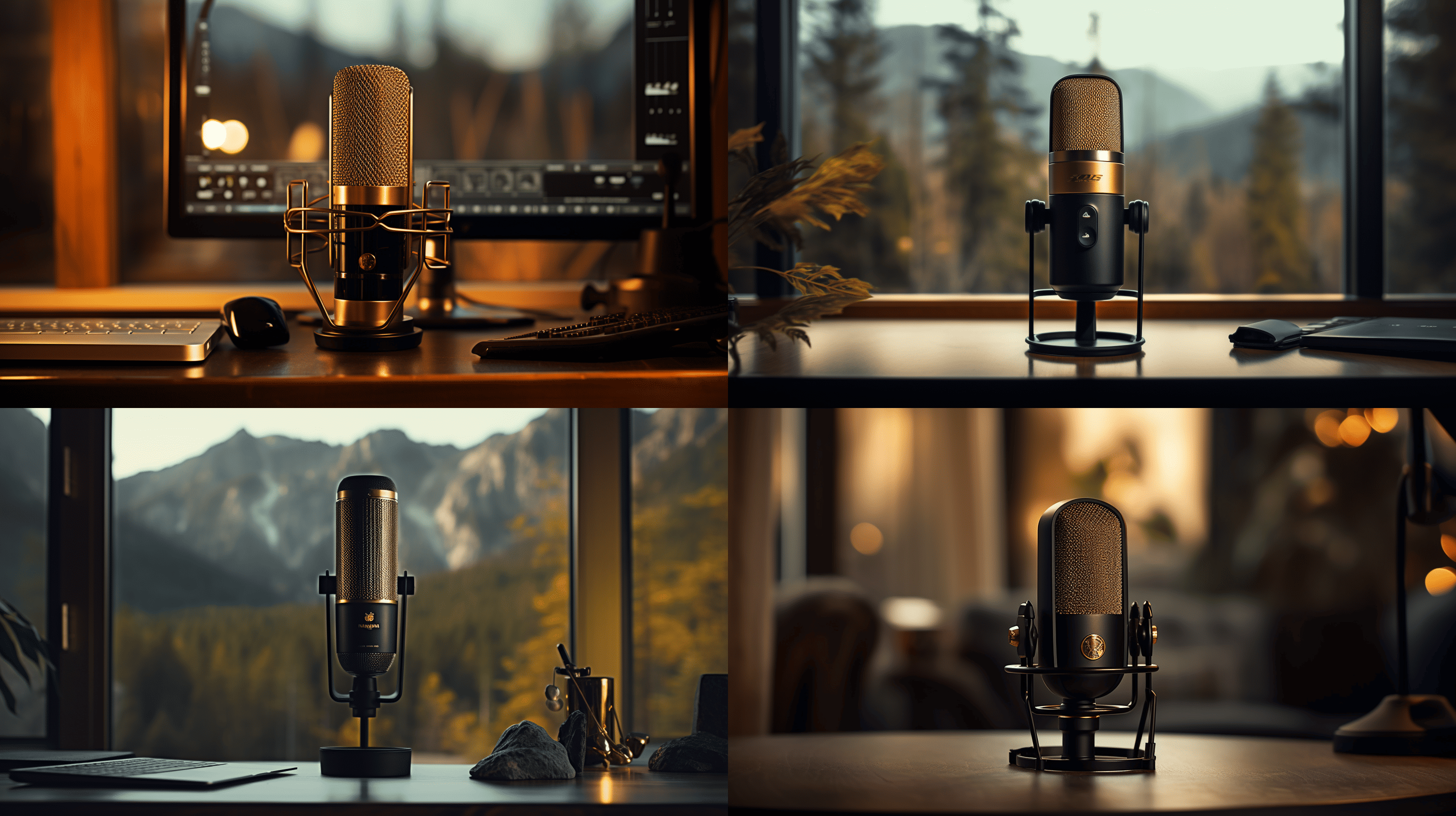Field Recording
Master the Art of Capturing Natural Sounds: How to Do Field Recordings

So, you want to venture into the world of field recordings? Well, grab your gear, but don't rush off just yet. There's a bit more to it than just hitting the record button.
We've all been guilty of underestimating the intricacies of capturing the perfect sound in the field, but fear not, because we've got some valuable insights to share. From selecting the right equipment to mastering the art of location scouting, we're about to uncover the essential elements that will elevate your field recording game to new heights.
Stick around to uncover the secrets behind creating captivating audio experiences that transport your audience to the heart of the action.
Key Takeaways
- Having versatile audio recording equipment is essential for field recordings, including a recorder with built-in stereo mics, headphones, additional microphones, wind protection, stands, grips, cables, and memory cards.
- Experimenting with microphone placement and utilizing stereo techniques like XY or ORTF can greatly enhance the quality of your recordings.
- When choosing locations for field recordings, prioritize diverse and interesting soundscapes, unique ambient noise in urban environments, rich wildlife or distinctive natural elements in natural settings, and thematically relevant locations for specific projects.
- To maximize the potential of your audio captures, choose the appropriate equipment, practice and experiment with different techniques, learn from experienced field recordists, and utilize windproofing solutions to control unwanted noise.
Essential Equipment for Field Recordings
When preparing for field recordings, it's essential to equip ourselves with a versatile audio recorder featuring built-in stereo mics, such as the Zoom H1n, Roland R-07, or Tascam DR-05, which are excellent budget-friendly options.
These devices are crucial for capturing high-quality field recordings, especially when it comes to recording natural sounds and ambient environments.
Along with the audio recorder, essential equipment for field recording includes headphones, additional microphones, wind protection (windshields and blimps), and stands, grips, cables, and memory cards.
To ensure the best results, it's important to select equipment that can effectively mitigate wind noise, as this can significantly impact the quality of the sound captured in outdoor environments.
Furthermore, the choice of recording format is crucial for sound design and post-production flexibility, with 24-bit WAV or AIF formats being ideal for high-quality field recordings.
Investing in the right field recording equipment is paramount for achieving professional results and capturing the true essence of the sounds present in the field.
Techniques for Capturing Quality Sounds

Capturing quality sounds in the field requires mastering various recording techniques. This includes experimenting with microphone placement and utilizing stereo techniques like XY or ORTF for a more immersive experience.
When recording nature sounds, it's crucial to use windshields or pop filters to reduce wind noise. It's also important to position the microphone close to the sound source for clarity.
In urban environments, it's important to choose a quiet location for better audio quality. Considering the time of day can help avoid unwanted background noise.
Additionally, using a stereo mic can provide a more natural and spatial representation of the environment.
Paying attention to the sample rate when recording is important. Higher sample rates can capture more detail and nuances in the sound.
After capturing the audio, utilizing audio editing software can be helpful. This can help remove unwanted noise or background sounds, adjust EQ, compression, and other effects to enhance the recording.
Field recordists should also respect local laws and regulations regarding recording in public spaces. It's important to obtain permission when recording on private property or sensitive locations.
Lastly, keeping backup copies of recordings is essential to prevent data loss.
Finding Ideal Locations for Recording
To find ideal locations for recording, consider scouting diverse and interesting soundscapes in urban environments, natural settings, or specific locations relevant to your project. When scouting for ideal locations, it's crucial to prioritize the quality of the sounds you aim to capture.
In urban environments, for instance, seek out areas with unique ambient noise, such as bustling marketplaces or echoing alleyways.
In natural settings, explore environments with rich wildlife or distinctive natural elements that can add depth to your recordings.
For specific projects, look for locations that are thematically relevant, such as historical sites or industrial zones.
Additionally, consider the time of day and weather conditions, as they can significantly impact the sounds you capture.
To capture high-quality audio in these diverse locations, experiment with different microphone placements and recording techniques. Utilize equipment such as the Zoom H1n or Zoom H4n with external microphones to ensure good quality recordings.
Engage with the environment and interact with potential sound sources to create unique and captivating recordings.
Be mindful of potential environmental challenges such as wind noise and ambient sounds, and strategize ways to mitigate these factors for optimal results.
Maximizing the Potential of Your Audio Captures

We can optimize the potential of our audio captures by carefully selecting the appropriate equipment and employing effective recording techniques.
When it comes to choosing the right equipment, consider the purpose of your recordings and select an audio recorder with good XLR inputs or built-in mics based on your needs and budget.
Additionally, practicing and experimenting with different techniques will help you hone your skills and enhance the quality of your recordings.
Here are some ways to maximize the potential of your audio captures:
- Choose the Right Equipment
- Consider the purpose of your recordings
- Select an audio recorder with good XLR inputs or built-in mics
- Practice and Experiment
- Regularly make recordings
- Learn from experienced field recordists to hone your skills
Tips for Successful Field Recordings
Maximizing the potential of our audio captures through careful equipment selection and skill development sets the stage for successful field recordings. To achieve great results, it's essential to consider the following tips:
| Tip | Description | Example |
|---|---|---|
| Use the right tools | Choose equipment suited to your recording environment, such as the Zoom H6 for versatile recording. | Utilizing a windscreen for outdoor recordings. |
| Pay attention to environmental sounds | Be mindful of the sound you're going for and use windproofing solutions to control unwanted noise. | Using a parabolic dish to capture distant sounds. |
| Experiment and practice regularly | Develop your skills by experimenting with different techniques and practicing regularly. | Recording various types of sound to refine your craft. |
Frequently Asked Questions
What Do You Need for Field Recording?
For field recording, we need to carefully consider:
- Microphone selection: Choosing the right microphones is crucial for capturing high-quality sounds.
- Outdoor environment: Outdoor recording demands durable equipment and wind protection to combat environmental factors.
- Sound isolation: Adequate battery life and memory capacity are essential for uninterrupted recording.
- Wind protection: Wind protection is necessary to prevent unwanted noise from interfering with the recording.
- Battery life: Having a sufficient battery life is important to ensure uninterrupted recording sessions.
- Memory capacity: Sufficient memory capacity is necessary to store all the recorded audio.
- Sound monitoring: Monitoring the sound during recording helps ensure optimal results.
- Post-processing: Post-processing techniques can be used to enhance the recorded audio.
- Equipment maintenance: Regular maintenance of equipment is important to keep it in good working condition.
- Field safety: Ensuring safety during field recording is always a priority.
What Is the Best Field Recorder for Beginners?
For beginners, the best field recorder should have a small, portable setup with built-in stereo mics. Consider models like Zoom H1n or Tascam DR-05 for budget-friendly options.
If wildlife sounds or urban exploration are of interest, location scouting and microphone options are crucial. Regular equipment maintenance is essential for optimal performance.
Experiment with different field recording techniques in various recording environments to capture atmospheric ambience. Sound editing skills will enhance the final recordings.
What Is the Best Sample Rate for Field Recording?
When comparing sample rates for field recording, we consider:
- Environmental noise
- Wildlife techniques
- Signal to noise ratio
- Equipment choices
- Post processing software
- Challenges
- Mic placement
- Weather impact
- Storage solutions
A sample rate of 44.1kHz is widely accepted, balancing quality and file size.
For high-frequency sounds, 48kHz or 96kHz may be better. Higher rates offer more detail but require more storage.
Ultimately, the best rate depends on project needs and equipment capabilities.
What Is a Field Audio Recorder?
A field audio recorder is portable equipment designed to capture high-quality sound recordings in various sound environments. It allows for versatile recording techniques, adjustable microphone placement, and external power options. Wind protection and monitoring headphones are essential for accurate sound capture.
Post processing enhances the recorded audio. Field audio recorders are ideal for capturing wildlife sounds and urban ambiance, providing a rich audio tapestry for creative projects.
What Are Some Techniques for Capturing Natural Sounds in Field Recordings?
Capturing natural sounds in field recordings requires a few techniques. Using high-quality microphones and wind protection can minimize interference. Positioning the mic strategically can also enhance the quality of the recordings. In the fascinating world of field recordings, these techniques are crucial for authentic and immersive soundscapes.
Conclusion
In conclusion, field recording is like painting with sound, capturing the intricate details of our sonic world. With the right equipment and techniques, you can create a masterpiece of audio that transports listeners to the heart of nature or the pulse of a bustling city.
So grab your gear, find your perfect location, and let the symphony of the world unfold through your recordings. Happy capturing!
Field Recording
Unlock the Magic of Rain: Dive into the Art of Field Recording in the Deluge

Field Recording in The Rain
Are you interested in bringing a unique and mesmerizing aspect to your audio projects? Consider capturing the essence of rain through field recording! The sound of rainfall goes beyond mere background noise—it serves as a source of musical inspiration and can significantly elevate your work. While venturing into moist and unpredictable conditions to record may present some obstacles, equipped with the appropriate tools and a bit of perseverance, you’re able to record extraordinary sounds that evoke the sense of a rainy day or infuse your projects with a deep, atmospheric quality. So, why not embrace nature’s challenge and dive into the world of field recording amidst the rain?
Soaked Sounds: Recording in the Rain
Why not add some precipitation to your recordings and make them more interesting with field recording in the rain?
The rain isn’t just noise, it’s music – so why not capture it and create something beautiful?
It might be wet and wild outside, but you can still make great recordings – just bring the right gear and some determination!
Think outside the studio and embrace the elements for a unique sonic experience with field recording in the rain.
The Sound of Water: Capturing Nature’s Music
Water is one of the most versatile and evocative sounds in nature. From the gentle trickle of a brook to the crashing waves of the ocean, water can inspire all kinds of music and art. When recording water sounds, you can capture a wide range of textures and rhythms, and over time, the sound of water changes and evolves, offering endless possibilities for creative exploration.
One of the benefits of using water sounds in your recordings is that water interacts with other environmental elements in unique ways. The sound of water hitting different surfaces, like leaves or rocks, can create a vibrant soundscape that captures the essence of the environment.
Whether you’re recording close-up droplets or distant waves, capturing the sound of water can add depth and emotion to your audio projects. The next time you’re out in nature, take a moment to appreciate the beauty of water and consider how you can use it in your field recordings.
Rainy Day Rhythms: Finding Inspiration in the Storm
Rainy days may seem dull and dreary, but they can actually be a great source of inspiration for musicians and sound designers. With a bit of field recording in the rain, you can capture a range of unique sounds that can add depth and texture to your music.
The sound of raindrops hitting different surfaces can create all kinds of rhythms and textures that can be used in music production. Whether it’s the gentle pitter-patter of rain on a rooftop or the loud and constant patter of an intense storm, there’s something magical about the sounds of rain that can bring a composition to life.
In addition to the sounds of rain itself, there are also many other environmental elements that you can capture during a rainy day recording session. The sound of thunder, wind, and even individual raindrops hitting different surfaces offer endless possibilities for creative exploration.
Not only can the sounds of rain add depth and texture to a musical composition, but they can also help capture the feeling of a rainy day. This can create a sense of nostalgia and emotional connection with the listener, making the music more memorable and impactful.
So, next time it’s raining outside, grab your recording gear and embrace the elements for a new sonic adventure. Who knows what kind of musical magic you might discover in the storm.
Dancing in the Rain: How to Keep Your Gear Dry
Recording sounds in the rain can be exhilarating, but it can also be risky for your equipment. Here are some tips to keep your gear dry:
- Invest in weather-resistant gear. Look for rain covers for your microphones and other equipment.
- Use plastic bags or rain ponchos to protect your gear when necessary.
- Set up your equipment under a waterproof canopy or umbrella. This will not only keep your gear dry but also provide a shelter for you.
- Keep a towel or shammy handy to wipe off any excess water that gets on your gear.
- Stay alert and keep an eye on the weather. If you notice lightning or heavy downpours coming, have an exit plan ready.
- Consider filming or recording near an overhang or other structure that can protect you and your gear from the rain.
With a little bit of planning and preparation, you can dance in the rain and make great recordings without worrying about damaging your gear.
Making Music with Mother Nature: Using Natural Elements in Your Recordings
Nature is full of amazing sounds that can be used to create unique and interesting musical projects. Whether it’s the birds singing, leaves rustling or wind blowing, incorporating natural sounds can add depth and texture to your music.
Recording natural sounds can also help you connect with the environment and spread awareness about issues like climate change and deforestation. By using these sounds in your music, you can create a sense of urgency and bring attention to important issues.
Experimenting with natural sounds is not just a creative pursuit, but an opportunity to learn and appreciate the world around us. By listening closely to the environment we live in, we can find inspiration and create something truly beautiful.
- Use a high quality microphone to capture the nuances of natural sounds.
- Avoid recording in noisy environments or during peak traffic hours to minimize background noise.
- Make sure to properly credit any natural sounds used in your music.
- Try layering different natural sounds together to create a unique sonic landscape.
By incorporating natural sounds into your music, you can create a unique and powerful artistic statement. Not only will your music stand out from the crowd, but you’ll be raising awareness about important environmental issues as well.
The Art of Field Recording: Techniques for Capturing Environmental Sounds
Field recording is a specialized skill that requires a combination of technical knowledge, creativity, and an ear for sound. Whether you’re capturing the sound of nature, urban environments, or human activity, there are certain techniques that can help you achieve the best results.
Microphone Placement
One of the most important aspects of field recording is microphone placement. Depending on the environment and the sound you’re trying to capture, you may need to use different microphone techniques. For example, if you’re recording outdoor wildlife, you may want to use a stereo microphone setup to capture a sense of space and depth. If you’re recording a specific sound, such as a car engine or a musical instrument, you may need to use close miking techniques to isolate the sound and reduce ambient noise.
Ambient Sound
Ambient sound is the background noise present in any recording environment, and it can play a significant role in the overall sound of your recording. When you’re field recording, it’s important to pay attention to the ambient sound and try to reduce or control it as much as possible. This can be done by choosing a quiet location, using directional microphones, or waiting for a quiet moment to begin recording.
Wind Noise
Wind noise can be a problem when field recording, especially in outdoor environments. To reduce wind noise, you can use wind protection on your microphone or choose a location that is sheltered from the wind. Alternatively, you can try to use the wind creatively in your recordings, by capturing the sound of wind blowing through tree branches or creating a sense of movement and energy.
Recording Formats
When you’re field recording, it’s important to choose the right recording format for your project. For example, if you’re recording sound effects for a film or video game, you may want to use a high-quality, uncompressed format like WAV or AIFF. If you’re recording for a podcast or online video, you may be able to use a compressed format like MP3 or AAC without sacrificing too much quality.
Experimentation
Field recording is a creative pursuit, and there is no one “right” way to do it. To get the best results, it’s important to experiment with different techniques, equipment, and locations. You may discover new techniques that work well in certain environments or with certain types of sound. By continuing to experiment and learn, you can develop your own unique style of field recording and capture sounds that are truly original and inspiring.
Recreating Rain: Using Foley for Film and TV Productions
Rain is a common element of film and TV productions, and Foley artists are responsible for recreating these sounds in the studio. Foley is the reproduction of everyday sounds for use in film and video production. Using a variety of tools like rain sticks, buckets, and splashing water, Foley artists can create realistic rain sounds that match the visuals on screen.
Not only is Foley about creating realism, but it’s also about creating a sense of mood and emotion that enhances the viewer’s experience. Every rain event has a unique sound, and recreating that sound is a challenge that Foley artists embrace.
The creativity and ingenuity of Foley artists can often go unnoticed. Next time you’re watching a rainy scene in a movie or show, take a moment to appreciate the hard work of these artists who make it all possible.
Rainy Ambience: How to Create Atmospheric Soundscapes
Ambient soundscapes can be incredibly immersive and transportive, and using field recordings of rain can add a special quality to them. Here are some tips for creating your own rainy soundscapes:
1. Layer Your Recordings
Layering rain sounds with other environmental elements like birds, insects, and even traffic, can create a complex and engaging audio environment. Start by collecting various field recordings and experimenting with different combinations and levels.
2. Play with Panning, Filtering, and Reverb
Playing with these effects can help create a sense of space and depth, offering a more realistic and dynamic listening experience. Try experimenting with different settings and see which ones work best for your chosen soundscape.
3. Use EQ to Balance Your Mix
Equalization can help you balance the frequency spectrum of your mix, making sure that no element is too overpowering or lacking. Use EQ to remove any unwanted frequencies, accentuate certain sounds, and make sure that everything sits well together.
4. Think About the Mood You Want to Convey
Do you want your soundscape to be calming and meditative, or do you want it to have a more intense and dramatic character? Think about the mood you want to convey and choose your sounds accordingly.
5. Remember to Listen to Your Mix in Different Environments
Make sure to listen to your soundscape on different playback systems and in different environments to make sure that it translates well. Be mindful of any unwanted background noise, distortion or imbalance, and adjust your mix accordingly.
Creating your own rainy ambience may take some time and experimentation, but with the right tools and techniques, you can create a captivating soundscape that transports your listeners to a rainy day.
Riding the Storm: Exploring the Power of Thunder and Lightning Sounds
Thunder and lightning may be intimidating, but they can also be a source of incredible sound recording opportunities.
Capturing the power and energy of a storm can add a dramatic and awe-inspiring element to your audio projects.
Recording the sounds of thunder and lightning may require more care and caution, but the results can be well worth the effort and risk.
Next time you’re caught in a storm, grab your gear and head outside – you never know what kind of sonic adventure awaits.
Singing in the Rain: Tips for Recording Your Own Original Soundtrack
If you’re a musician or composer, the sound of rain can be a unique and inspiring backdrop for your music. Here are some tips for recording your own original soundtrack:
- Record the rain sounds first to establish the mood and atmosphere of your piece.
- Experiment with different microphones and placements to capture the rain sounds in a way that complements your music.
- Consider incorporating other environmental sounds like thunder, birds or wind for a fuller, more dynamic experience.
- Use the rain sounds as a base for your composition and layer other instruments and elements to create a complete musical piece.
- Don’t be afraid to get creative and try new things. Rain recordings can offer a lot of versatility and potential for musical experimentation.
Singing in the rain takes on a whole new meaning when you’re recording your own original work – who knows what kind of magic you’ll create?
Can Field Recording in the Rain Enhance the Cinematic Experience of Shooting a Movie on Film?
Field recording in the rain can truly enhance the cinematic experience of shooting a movie on film. The natural sound of rainfall adds depth and emotion to the scenes, reviving the art of filmmaking by creating an immersive and atmospheric storytelling experience for the audience.
Conclusion
In conclusion, field recording in the rain offers a unique and exciting opportunity for sound enthusiasts, musicians, and artists. The sound of rain, water, thunder, and lightning can inspire creativity, evoke emotions, and add depth and texture to various audio projects.
However, recording in the rain requires preparation, skill, and caution to ensure the safety of equipment and personal well-being. With the right gear, techniques, and mindset, field recording in the rain can be a fulfilling adventure that brings us closer to nature and unlocks our creative potential. So, why not embrace the elements and let the rain be your muse? Who knows what kind of beautiful sounds and experiences you’ll capture and create?
Field Recording
Mastering Field Record Tables and Queries: Tips and Best Practices

So, you know how we often come across large sets of data in our work, and it can feel like searching for a needle in a haystack? Well, that's where field record tables and queries come into play. They serve as the backbone of organizing and retrieving specific information from these vast databases.
Understanding how these tables are structured and how queries can be used to extract precise data is crucial for anyone working with databases. It's like having a map to navigate through a dense forest of information.
But there's more to it than just that, and getting a handle on these concepts can really streamline our data management processes.
Key Takeaways
- Fields are the building blocks of records in a database and represent specific pieces of information.
- Tables have fields organized in columns and records arranged in rows, and data validation and indexing techniques ensure accuracy and performance optimization.
- Querying and retrieving data involves filtering with the WHERE clause, using logical operators and wildcard characters, and sorting with the ORDER BY clause.
- Establishing relationships between tables using primary keys and employing data normalization techniques ensure data integrity and manageable structure.
Understanding Fields and Records
How do fields and records relate to one another within a database, and what purpose do they serve in organizing data?
In a database, fields are the building blocks of records, representing specific pieces of information such as names, dates, or numerical values. Each record consists of a collection of related data fields that collectively describe an individual entity or item.
For example, in a database of employees, fields may include name, employee ID, department, and salary. These fields come together to form a record for each employee, organizing specific information about them within the database.
The relationship between fields and records is fundamental to the organization of data within a database. Tables, which are collections of records, are structured with fields as column headers and records as rows. This arrangement allows for efficient storage and retrieval of information.
When a new record is created, it contains specific data within its fields, ensuring that each entity within the database is accurately represented. Understanding the interplay between fields and records is essential for creating a well-organized and functional database.
Essential Components of a Table

Essential components of a table include fields organized in columns and records arranged in rows, representing specific entities or concepts within a database.
Data validation techniques are crucial for maintaining the accuracy and consistency of data within the table. This involves implementing checks and rules to ensure that only valid data is entered into the fields, preventing errors and inconsistencies.
Additionally, indexing and performance optimization are essential for efficient data retrieval and manipulation. By creating indexes on the fields, the database system can quickly locate and access the required data, enhancing overall performance.
Moreover, data integrity and constraints play a vital role in maintaining the reliability and correctness of the data. Constraints such as unique constraints, primary key constraints, foreign key constraints, and check constraints help enforce data integrity by imposing rules on the data that can be entered into the table, thereby preventing inconsistencies and inaccuracies.
Querying and Retrieving Data
Querying and retrieving data from a database involves the extraction of specific information. When working with databases, it's essential to understand data filtering, sorting techniques, and advanced query optimization to efficiently retrieve the required information. Here are some key points to consider:
- Data Filtering:
- Utilize WHERE clause in SQL to filter records based on specified conditions.
- Use logical operators such as AND, OR, and NOT to refine filtering criteria.
- Understand wildcard characters like % and _ for pattern matching in filtering.
- Sorting Techniques:
- Employ ORDER BY clause to sort retrieved data in ascending or descending order.
- Utilize multiple fields for sorting to arrange data hierarchically.
- Consider indexing frequently used sorting fields for improved query performance.
- Advanced Query Optimization:
- Use EXPLAIN statement in databases to analyze query execution plans.
- Consider utilizing indexes, materialized views, and query caching for performance optimization.
- Understand query optimization techniques such as join optimizations and subquery optimizations to enhance query efficiency.
Mastering these aspects of querying and retrieving data is crucial for efficiently working with databases and extracting valuable insights.
Relationships Between Tables and Records

Establishing relationships between tables and records in a database is fundamental for structuring and organizing data efficiently. The primary key importance can't be overstated in this context. A primary key uniquely identifies each record in a table and serves as the basis for establishing relationships with other tables.
Types of relationships include one-to-one, one-to-many, and many-to-many. In a one-to-one relationship, each record in one table is related to only one record in another table. In a one-to-many relationship, a record in one table can be related to one or more records in another table. A many-to-many relationship involves multiple records in one table being related to multiple records in another table.
To ensure data integrity and eliminate redundancy, data normalization techniques are employed. This process organizes data in a way that reduces duplication and dependency, resulting in an efficient and manageable database structure.
Understanding and implementing these relationships and techniques are essential for effectively managing and querying database information.
Optimizing Queries for Efficient Data Retrieval
To achieve efficient data retrieval, it's crucial to structure queries in a manner that optimizes their performance. When optimizing queries for efficient data retrieval, several key strategies can be employed:
- Index Optimization: Utilize appropriate indexes on fields involved in the queries. This can significantly enhance the speed of data retrieval by allowing the database engine to quickly locate the relevant data.
- Query Optimization: Analyze and restructure queries to ensure they're written in the most efficient way possible. This may involve avoiding unnecessary joins, reducing the number of columns retrieved, and optimizing the order of operations within the query.
- Query Execution Plans: Utilize query execution plans provided by database management systems to understand how queries are processed and executed. This can help in identifying potential bottlenecks or inefficient query structures, allowing for optimization.
Frequently Asked Questions
What Is the Definition of Record Field Table and Query?
Record, field, table, and query are fundamental database elements.
A record is a single data entity, with fields representing specific attributes.
Tables organize records into rows and columns.
A query retrieves specific records based on defined criteria.
Understanding their definition, structure, and usage is crucial for effective database management.
What Is Table and Query?
Table structure refers to the organization of data in rows and columns within a database. Data retrieval involves extracting specific information from tables using queries.
Query optimization focuses on improving the efficiency and performance of database queries. It's essential to understand the table structure to optimize queries for faster data retrieval.
We must consider query optimization techniques to enhance the overall performance of the database system.
What Is the Difference Between Table and Query in MS Access?
In an Access database, the table stores structured data, while the query retrieves and manipulates data based on defined criteria.
The table represents entities or concepts, while the query enables data retrieval techniques.
This distinction is crucial for mastering Access database management.
Tables act as the foundational structure, while queries serve as the dynamic tool for accessing and analyzing the stored data.
Understanding this difference is essential for effective data management in MS Access.
What Is a Record in a Query?
In a query, a record is the fundamental unit of data retrieval and manipulation. It represents a single entity's information within the record structure. Understanding this allows for efficient record filtering and query optimization.
Conclusion
In conclusion, understanding the components of a field record table and how to query and retrieve data is essential for efficient database management.
By optimizing queries and understanding the relationships between tables and records, we can ensure that data retrieval is smooth and effective.
It's like finding the perfect piece of information in a sea of data, making our work easier and more satisfying.
Field Recording
Uncover the Mystery: Why Aren’t My Recorded Calls Showing Up?

So, we've run into a bit of a hiccup with our recorded calls not showing up, and it's been a bit of a head-scratcher for us.
It's frustrating, I know, but there are a few potential reasons for this that we need to explore. From app compatibility issues to storage space constraints, or even permissions snags, there's quite a bit to consider.
Stick around to uncover the potential causes and some troubleshooting tips to get those elusive recorded calls back on track.
Key Takeaways
- Incompatible call recording apps can cause issues with call recordings. Updating the app to a version that is compatible with the device's specifications may resolve the problem.
- Insufficient storage space on the device can prevent call recordings from being saved. Clearing unnecessary files and data, transferring recordings to a different storage location, and regularly monitoring storage space can help free up space.
- Disabled call recording permissions can affect the functionality of call recording apps. Checking and enabling the necessary permissions for the app is important for successful call recording.
- Software or operating system issues can interfere with call recording. Lack of necessary permissions, bugs in the phone app, and regulations prohibiting call recording can all impact the functionality of call recording apps.
Incompatible Call Recording App
When encountering issues with recorded calls not showing up, it's crucial to consider the possibility of an incompatible call recording app causing the problem. Incompatibility issues can arise if the call recording app isn't optimized for the specific Android version or device model being used. This can result in the app failing to capture and display recorded calls properly.
To address this, ensure that the call recording app is compatible with the Android version installed on the device. Additionally, verify if the app is designed to work seamlessly with the specific device model. Updating the call recording app to a version that's compatible with the device's specifications may resolve the issue of recorded calls not showing up.
It's important to note that using third-party call recording apps may also contribute to compatibility issues. Some third-party apps may not fully integrate with the device's native call recording functionality, leading to inconsistencies in call recording visibility. In such cases, consider using the native call recording feature, if available, or switch to a call recording app that's known to be compatible with the device and Android version in use.
Insufficient Storage Space

We must address the issue of insufficient storage space on the device, as it can hinder the saving of call recordings. When the available storage space is limited, the call recorder app may encounter difficulties in creating new recordings, leading to the 'Call Recorder Not Recording' issue.
To resolve this, we can start by clearing unnecessary files and data from the device. This can be achieved by removing temporary files from other apps or system processes that might be consuming a significant amount of space.
Additionally, consider transferring existing recordings to a different storage location, such as a cloud service, to free up space for the recording function to work efficiently.
Another effective approach is to regularly monitor the storage space on the device and uninstall unused apps or media files to ensure an adequate amount of free space is always available.
Disabled Call Recording Permissions
Addressing the issue of insufficient storage space is pivotal in understanding the implications of disabled call recording permissions, as it directly impacts the functionality of call recording apps.
When call recording permissions are disabled on an Android phone, the phone app is unable to access the necessary features to record calls. This can occur on older Android devices or in regions with strict call recording laws, where permissions may be disabled by default.
As a result, users may experience issues with call recording apps not functioning properly or recorded calls not showing up in the app. It's important to check the permissions settings for the call recording app and ensure that the necessary permissions are enabled to allow the app to record calls successfully.
Additionally, users should consider updating their Android devices to newer versions that support call recording permissions to avoid any potential issues with call recording functionality.
Software or Operating System Issues

Software limitations can impact the functionality of call recording apps on Android devices. Issues within the operating system or the call recorder app itself can lead to failed recordings. For instance, the call recorder app may not have the necessary permissions to access the phone's audio and record calls.
Additionally, if the phone app has bugs, especially when using a beta version of the Android OS, it can interfere with the call recording process. Moreover, some countries have regulations that prohibit call recording, leading to restrictions on the use of call recorder apps.
Furthermore, temporary files cluttering up the cache of the Phone app can hinder call recording by consuming the available storage space. It's also worth noting that Android devices running on Android 8 or lower may not fully support call recording due to limitations within the operating system.
Therefore, it's essential to ensure that both the software and operating system are compatible with the call recorder app, and that all necessary permissions are granted for seamless call recording functionality.
Call Recording File Corruption
Due to potential issues with call recording apps and the Android operating system, call recording file corruption can lead to the inability to access or play recorded calls on the device. When call recording files become corrupted, it can result in distorted audio or render the files completely unplayable.
The corruption of these files may stem from various factors such as problems with the recording app, storage issues, or conflicts within the device's software. To address call recording file corruption, several troubleshooting steps can be taken, including:
- Clearing the app's cache
- Updating the recording app to the latest version
- Checking for storage space availability
- Ensuring that the device's operating system is up to date
If these steps don't resolve the issue, seeking support from the app developer or technical support may be necessary to diagnose and address the underlying cause of the file corruption.
It's crucial to address call recording file corruption promptly to ensure the integrity and accessibility of recorded calls for future reference.
Frequently Asked Questions
Why Is Call Recording Not Showing?
Troubleshooting call recording involves several steps:
- Checking call recording settings: Ensure that the call recording feature is enabled in the phone settings. Some devices have a built-in call recording option that needs to be activated.
- Checking call recording software: If you are using a third-party call recording app, make sure it is up to date. Check for any available updates and install them if necessary.
- Checking call recording storage: Verify that you have enough storage space available on your device to save the recorded calls. If the storage is full, delete unnecessary files or transfer them to an external storage device.
- Checking call recording privacy: Ensure that the call recording app has the necessary permissions to access the microphone and storage. Go to the app settings and grant the required permissions if they are not already enabled.
- Checking legal requirements: In some countries, call recording is not allowed without the consent of all parties involved. Make sure that call recording is allowed by the country's law before using this feature.
In addition to the above steps, clearing temporary files cluttering up the cache of the Phone app can resolve visibility issues. However, please note that for Android devices running on Android 8 or lower, call recording may not be supported.
Where Did My Call Recording Go?
We can explore troubleshooting options for call recording file visibility issues. Storage issues or device compatibility might be the root cause. Privacy concerns could also impact the retrieval process. Checking permissions and app settings is crucial.
If the files aren't in the expected location, we might need to investigate further. It's important to ensure that the recording feature is compatible with the device and that the storage location is accessible.
How Do I Fix Call Recording Problem?
To troubleshoot call recording issues, there are several steps to follow:
- Ensure the app has proper permissions.
- Clear the phone app's cache.
- Check for legal restrictions.
Next, we need to verify if the device supports call recording and investigate any visibility issues. This can be done by:
- Adjusting call recording settings.
- Using compatible recording apps.
- Seeking tech support if necessary.
In cases where recordings are lost, we can explore retrieval options. By following these measures, we can effectively resolve call recording problems.
How Do I Access My Recorded Phone Calls?
We've mastered accessing recorded phone calls.
Troubleshooting potential issues includes:
- Checking permissions
- Device compatibility
- File visibility in the Recorder app or File Manager
Ensure proper storage management and consider privacy concerns.
Playback options are crucial for a seamless experience.
Remember to navigate legal regulations regarding call recording.
With these technical insights, accessing recorded calls becomes a breeze.
Conclusion
In the journey of call recording, we may encounter obstacles that obscure our path. Just as a ship navigates through stormy seas, we must navigate through bugs, permissions, and legal restrictions.
By updating, clearing, and checking our devices, we can clear the fog and reveal our recorded calls once more. Like a skilled captain, we can steer through these challenges and ensure our call recordings are always visible.
-

 Microphone1 month ago
Microphone1 month agoUnleash Your Inner Podcaster: Discover the Best Microphone for Crisp, Clear Audio
-

 Music Theory1 month ago
Music Theory1 month agoUnlocking Nature’s Harmony: The Power of 432 Hz Frequency in Sound & Music for Enhanced Living and Well-Being
-

 Sound Design1 month ago
Sound Design1 month agoWhat Is the Difference Between a Sound Engineer and A Sound Designer?
-

 Native Instruments Kontakt1 month ago
Native Instruments Kontakt1 month agoVOCAL AI – Animated Intelligence: The Ultimate Vocal Playground
-

 Sound Design1 month ago
Sound Design1 month agoWhy Sound Engineer
-

 Composing1 month ago
Composing1 month agoMUTILATED NOISE by SampleTraxx: The Next Generation Sound Collection
-

 Audio Production2 weeks ago
Audio Production2 weeks agoUnleashing Sound Therapy: Incorporating Acoustic Design in a Wellness Centre
-

 Expert Guides1 month ago
Expert Guides1 month agoHow Do You Become a Sound Designer















